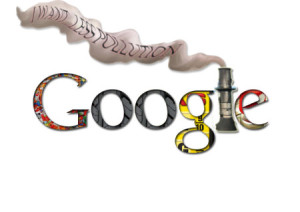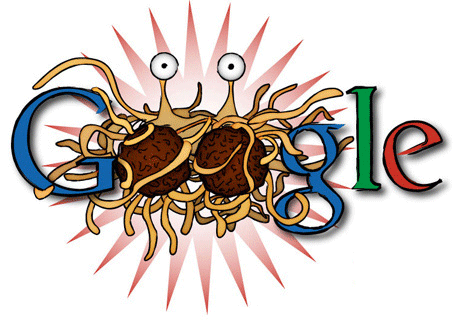Archive for the ‘Technology’ Category.
7th December 2012, 06:01 pm
 Did you know that one Google search creates CO2 emissions of at least 1g? And Chris Goodall, author of Ten Technologies to Save the Planet, even estimates the carbon emissions of a Google search to even be more like 7g to 10g (assuming 15 minutes’ computer use). Wissner-Gross has also calculated the CO2 emissions caused by individual use of the internet. His research indicates that viewing a simple web page generates about 0.02g of CO2 per second. This rises tenfold to about 0.2g of CO2 a second when viewing a website with complex images, animations or videos. Nicholas Carr, author of The Big Switch, Rewiring the World, has calculated that maintaining an avatar in the Second Life virtual reality game, requires 1,752 kilowatt hours of electricity per year. That is almost as much used by the average Brazilian.
Did you know that one Google search creates CO2 emissions of at least 1g? And Chris Goodall, author of Ten Technologies to Save the Planet, even estimates the carbon emissions of a Google search to even be more like 7g to 10g (assuming 15 minutes’ computer use). Wissner-Gross has also calculated the CO2 emissions caused by individual use of the internet. His research indicates that viewing a simple web page generates about 0.02g of CO2 per second. This rises tenfold to about 0.2g of CO2 a second when viewing a website with complex images, animations or videos. Nicholas Carr, author of The Big Switch, Rewiring the World, has calculated that maintaining an avatar in the Second Life virtual reality game, requires 1,752 kilowatt hours of electricity per year. That is almost as much used by the average Brazilian.
But what’s much worse is that Google through its business model (AdWords/AdSense) has created a never-ending pollution engine for the World Wide Web. Since there’s is is money to be made by having a page show up in Google’s search results an entire industry sprung up our off nowhere (SEO). And every single ‘contributor’ to that industry has only one goal in mind: how can I get my page to show up on top of Google’s result to sell what I have to offer. To this day the Google algorithm still employs a largely popularistic approach: mainly a page’s importance is measured by how many other pages/sites point (link) to it. Every other aspect of the logic just provides nuances.
So, just like 85% of all emails sent are SPAM, it is very likely that 85% of pages on the World Wide Web are SPAM and a lot of it is being presented to you by Google (and of course any other search engine) as legitimate content. Just ask yourself: if you search for ‘best cell phone’, ‘best car loan’ – what do you expect to find? A legitimate research paper?
Category:
Search,
Technology |
Comments Off on How Google pollutes your environment
17th December 2007, 02:13 pm
Android is a Linux-based operating system designed primarily for touchscreen mobile devices such as smartphones and tablet computers. Initially developed by Android, Inc., which Google (and my buddy Brian) backed financially and later purchased in 2005, Android was unveiled in 2007 along with the founding of the Open Handset Alliance: a consortium of hardware, software, and telecommunication companies devoted to advancing open standards for mobile devices. The first Android-powered phone was sold in October 2008. I made the mistake to buy it .. it s**cked 🙁
Android is open source and Google releases the code under the Apache License. This open source code and permissive licensing allows the software to be freely modified and distributed by device manufacturers, wireless carriers and enthusiast developers. Additionally, Android has a large community of developers writing applications (“apps”) that extend the functionality of devices, written primarily in a customized version of the Java programming language.
These factors have allowed Android to become the world’s most widely used smartphone platform[16] and the software of choice for technology companies who require a low-cost, customizable, lightweight operating system for high tech devices without developing one from scratch. As a result, despite being primarily designed for phones and tablets, it has seen additional applications on televisions, games consoles and other electronics. Android’s open nature has further encouraged a large community of developers and enthusiasts to use the open source code as a foundation for community-driven projects, which add new features for advanced users[18] or bring Android to devices which were officially released running other operating systems.
Category:
Technology |
Comments Off on What Is An ANDRIOD Phone?
30th August 2006, 12:36 pm
 Long range wireless remote controls are designed and produced in form of hand-held devices that control other devices from miles away. Battery lives of months and ranges measured in miles are all possible when combining advanced Radio and Digital techniques. Raveon’s wireless technologies span DSP, RF, antennas, and software – making quality radios that simply communicate farther. Our unique combinations of hardware and software allow us to produce wireless remote controls, that operate in unlicensed frequency bands, which will work over many miles using simple omni-directional antennas.
Long range wireless remote controls are designed and produced in form of hand-held devices that control other devices from miles away. Battery lives of months and ranges measured in miles are all possible when combining advanced Radio and Digital techniques. Raveon’s wireless technologies span DSP, RF, antennas, and software – making quality radios that simply communicate farther. Our unique combinations of hardware and software allow us to produce wireless remote controls, that operate in unlicensed frequency bands, which will work over many miles using simple omni-directional antennas.
The main remote control technology used in your home on the opposite is mostly infrared. The signal between a remote control handset and the device it is controlling are infrared pulses, which are invisible to the human eye. The transmitter in the remote control handset sends out a pulse of infrared light when a button is pressed on the handset. A transmitter is often a light emitting diode (LED) which is built into the pointing end of the remote control handset. The infrared light pulse represents a binary code that corresponds to a certain command, such as (power on). The receiver passes the code to a microprocessor, which decodes it and carries out the command.
In the 1980s Steve Wozniak started a company named CL 9. The purpose of this company was to create a remote control that could operate multiple electronic devices. The CORE unit (Controller Of Remote Equipment) was introduced in the fall of 1987. The advantage to this remote controller was that it could “learn” remote signals from different devices. It had the ability to perform specific or multiple functions at various times with its built-in clock. It was the first remote control that could be linked to a computer and loaded with updated software code as needed.
Category:
Technology |
Comments Off on Long Range Wireless Remote Controls
22nd May 2003, 02:07 pm
 Google claims that its mission is to organize the world‘s information and make it universally accessible and useful. At first look this seems to be a valuable goal. However, it is important to keep in mind that this mission is subordinate to the primary goal of any public company which is to increase the wealth of its shareholders by paying dividends and causing the stock price to increase.
Google claims that its mission is to organize the world‘s information and make it universally accessible and useful. At first look this seems to be a valuable goal. However, it is important to keep in mind that this mission is subordinate to the primary goal of any public company which is to increase the wealth of its shareholders by paying dividends and causing the stock price to increase.
Plagued by this paradigm Google adapted a business model in form of the AdWords and AdSense advertising programs that in its consequence led to the development of an entirely new industry: Search engine optimization which in its various forms – such as content farms – has caused an explosion of digital content that is essentially marketing copy disguised as information. In short: Google consequently organizes mostly the world’s ad copy rather than the world’s information. It is hence an utterly failed attempt to effectively organize information. Unless the search giant is willing to radically change its business model there seems no way out of the corner the company painted itself into.
I am working on an concept for building a better search engine that addresses the inherent conflict while attempting to put the challenge of information organization into a wider scope than simply ‘search’ and aim to push out a minimum viable product out this year.
Category:
Search,
Technology |
Comments Off on Google – a failed approach to information management
19th September 2000, 02:37 pm
 Virtual currencies haven been around for a very long time. In essence most customer loyalty programs fulfill the criteria of virtual currencies. So, Coca Cola’s ‘free drink vouchers’ issued in 1887 might have been the first. Digital versions seem to have first apperaed when Flooz came online in 1999.
Virtual currencies haven been around for a very long time. In essence most customer loyalty programs fulfill the criteria of virtual currencies. So, Coca Cola’s ‘free drink vouchers’ issued in 1887 might have been the first. Digital versions seem to have first apperaed when Flooz came online in 1999.
I think virtual currencies can be viewed as a form of ‘electronic money’ or area of payment system technology that might be evolving in the next decade expand over just game worlds. I came across a somewhat insightful hearing memo on the Future of Money before the Committee on Banking and Financial Services which is worth reading.
It seems very strange to me that we can now send emails for free but have to pay a bank tributes for the privilege of moving bits.
Category:
Technology |
Comments Off on Virtual Currencies
 Did you know that one Google search creates CO2 emissions of at least 1g? And Chris Goodall, author of Ten Technologies to Save the Planet, even estimates the carbon emissions of a Google search to even be more like 7g to 10g (assuming 15 minutes’ computer use). Wissner-Gross has also calculated the CO2 emissions caused by individual use of the internet. His research indicates that viewing a simple web page generates about 0.02g of CO2 per second. This rises tenfold to about 0.2g of CO2 a second when viewing a website with complex images, animations or videos. Nicholas Carr, author of The Big Switch, Rewiring the World, has calculated that maintaining an avatar in the Second Life virtual reality game, requires 1,752 kilowatt hours of electricity per year. That is almost as much used by the average Brazilian.
Did you know that one Google search creates CO2 emissions of at least 1g? And Chris Goodall, author of Ten Technologies to Save the Planet, even estimates the carbon emissions of a Google search to even be more like 7g to 10g (assuming 15 minutes’ computer use). Wissner-Gross has also calculated the CO2 emissions caused by individual use of the internet. His research indicates that viewing a simple web page generates about 0.02g of CO2 per second. This rises tenfold to about 0.2g of CO2 a second when viewing a website with complex images, animations or videos. Nicholas Carr, author of The Big Switch, Rewiring the World, has calculated that maintaining an avatar in the Second Life virtual reality game, requires 1,752 kilowatt hours of electricity per year. That is almost as much used by the average Brazilian.






